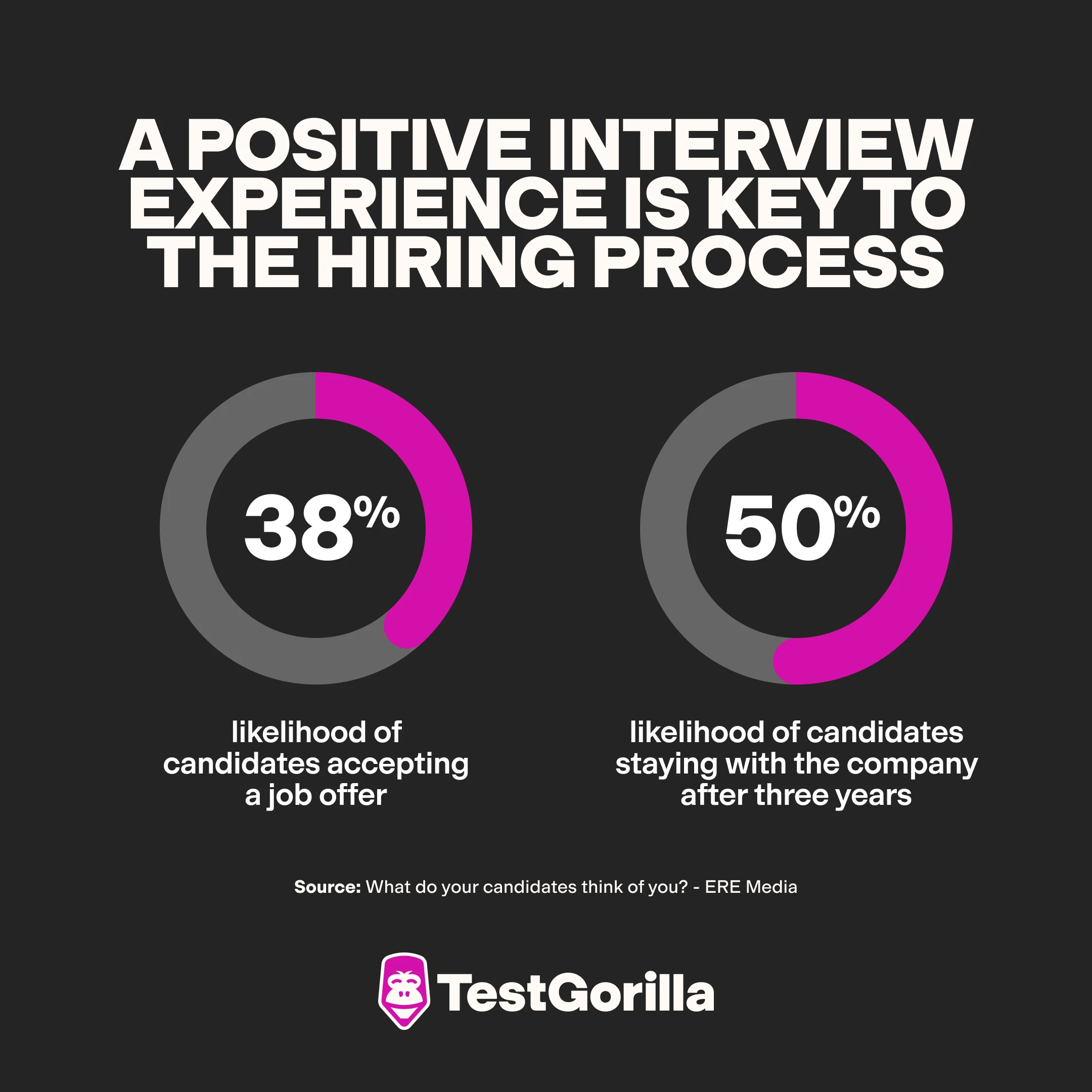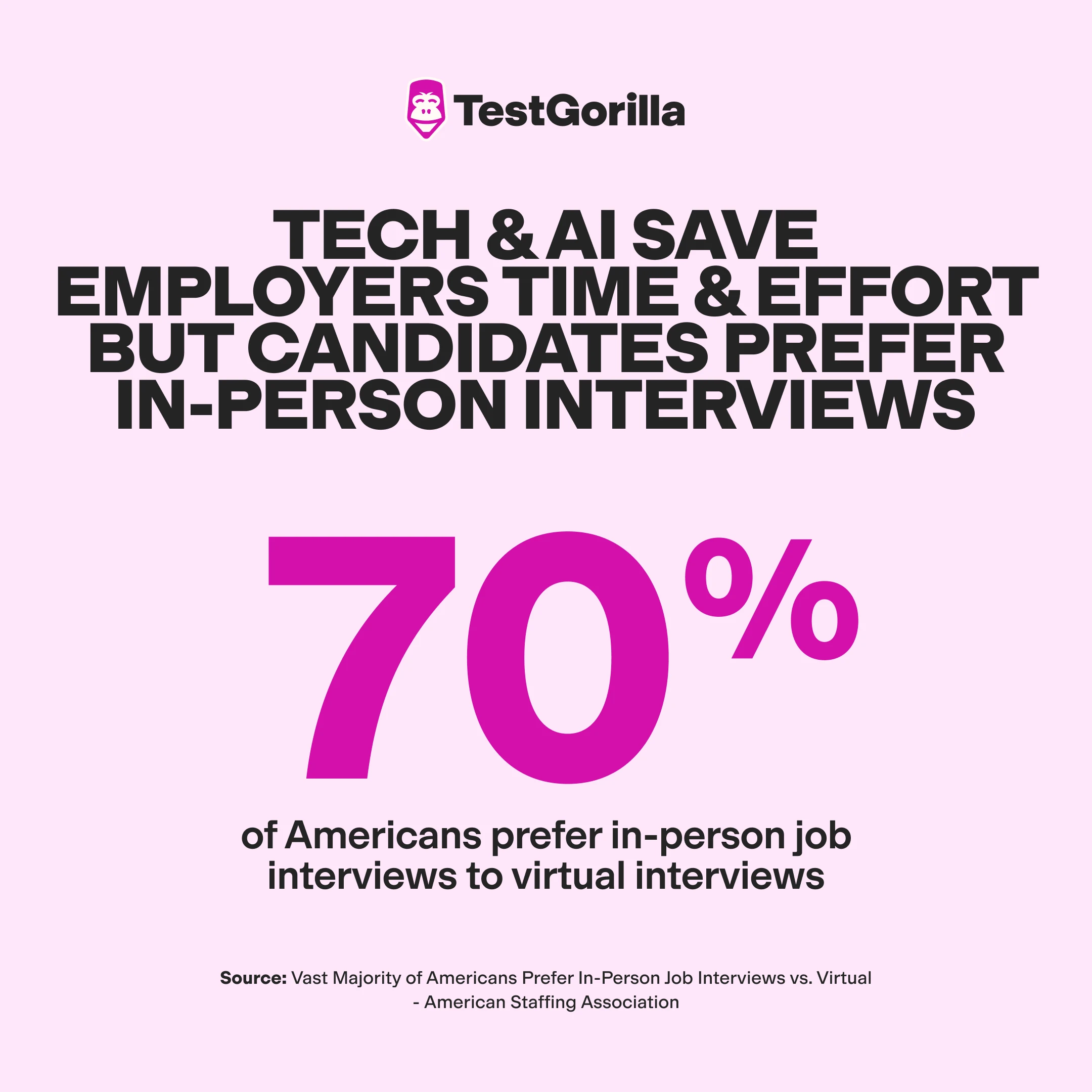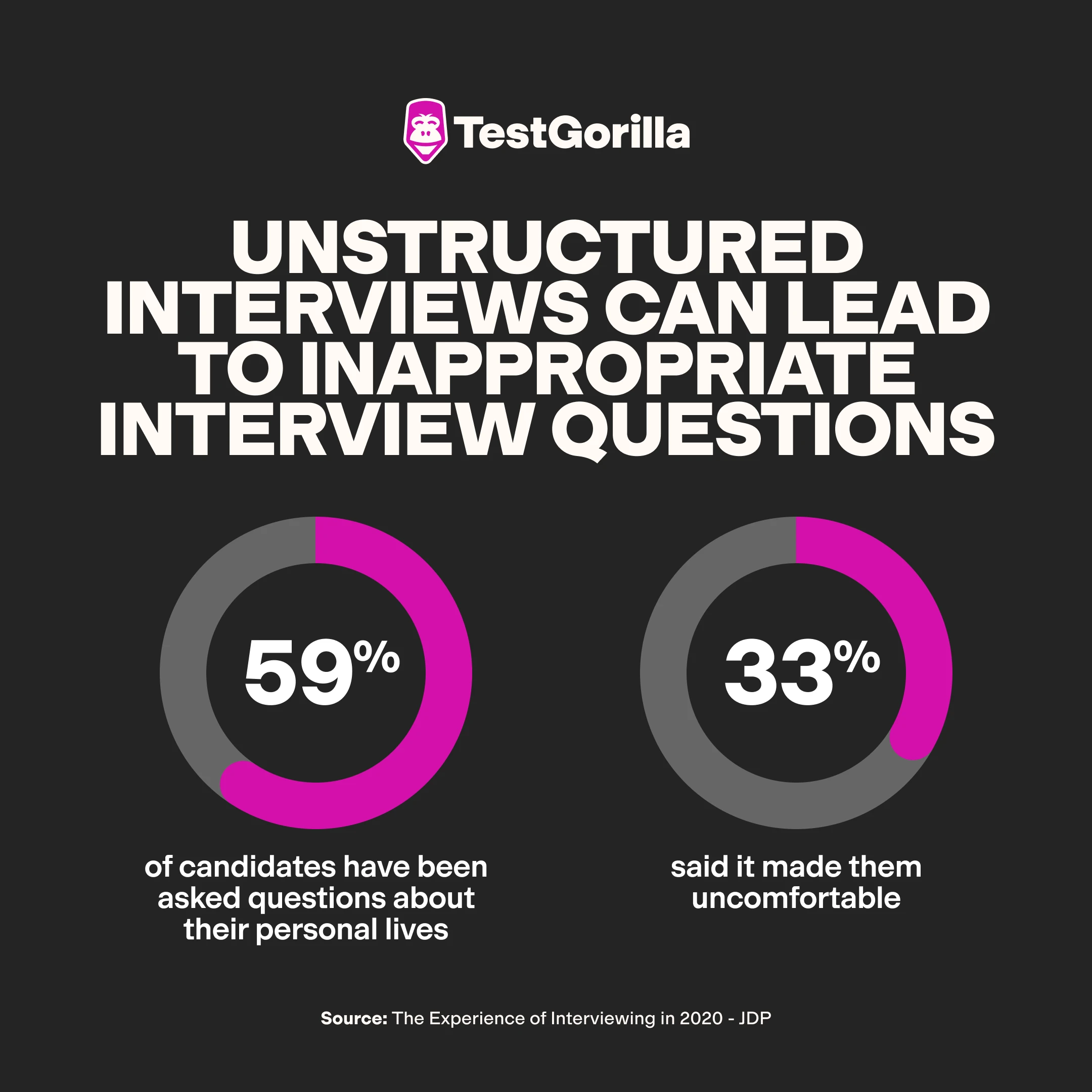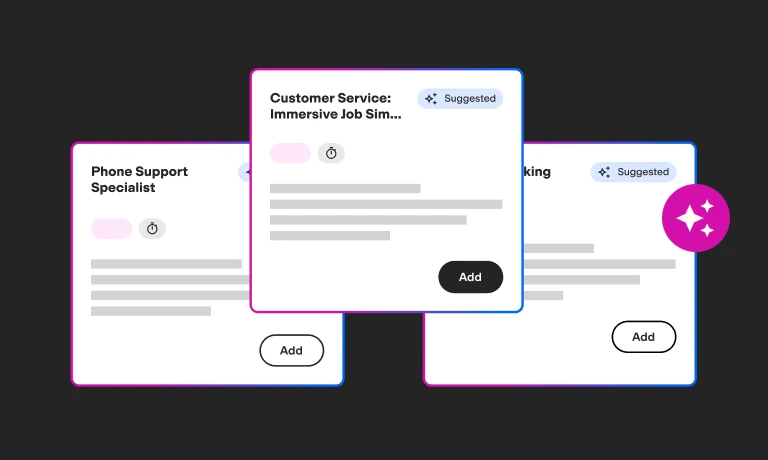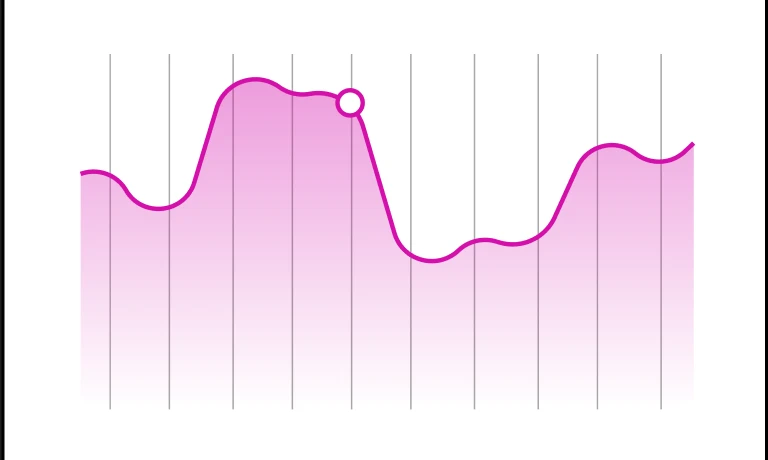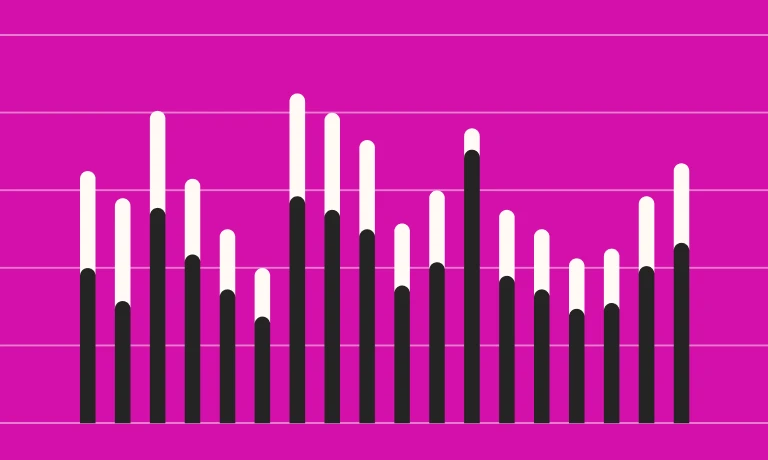Job interview statistics: Everything you need to know
Job interviews are a crucial part of hiring. They give both candidates and employers a chance to connect, understand each other, and assess job fit.
Despite their importance, many employers miss the mark when it comes to interviewing – resulting in costly mis-hires, a damaged employer brand, and wasted time and resources.
The good news? We’re here to help you avoid all of that.
In this article, we share 28 job interview statistics, plus trends and insights into what’s working best, so you can refine your interview process and land the top talent your company deserves.
Table of contents
- How we researched this topic
- Key takeaways
- The importance of interviews: Key numbers
- Current trends in job interviews
- Diversity-related interview insights
- Industry-specific interview insights
- Top challenges in the interview process
- Cost of ineffective interviews
- Strategies to measure and improve interview effectiveness
- Combine your job interviews with talent assessments
- FAQs
How we researched this topic
To ensure we provide reliable and accurate information, we've used data from reputable government sources and industry-leading organizations – such as the American Staffing Association, the Bureau of Labor Statistics, Gallup, Forbes, and the Harvard Business Review – and empirical studies published in scientific journals.
Key takeaways
Candidates with a positive interview experience are 38% more likely to accept a job offer.
82% of companies use virtual interviews, but 70% of candidates prefer in-person interviews.
Structured interviews have a higher predictive validity than unstructured interviews.
68% of candidates want the chance to showcase their skills during interviews and the overall hiring process.
The best insights on HR and recruitment, delivered to your inbox.
Biweekly updates. No spam. Unsubscribe any time.
The importance of interviews: Key numbers
We reviewed multiple studies and research papers, and they all agree that job interviews are costly and time-consuming but also key to the hiring process.
1. The average cost of a job interview in the US is $72.29 per candidate
According to Forbes, this includes travel costs, one hour of an interviewer's time at the median wage, and lunch and coffee expenses.
2. US employers spend approximately eight days a year conducting interviews
A Cambridge University paper also reported similar experiences in Switzerland, where companies spend about 8.5 hours to interview each candidate.
3. One in four job applicants said that after pay, job interviews had the biggest influence on their decision to accept a job offer
This data by Gallup, an analytics advisory company, highlights the importance of candidates’ interactions with hiring managers and other stakeholders.
Interviews allow job seekers to meet their hiring manager, potential colleagues, the company’s HR manager, and more. In-person interviews let them see the company’s physical workspaces, giving them a better idea of its people, working practices, culture, and values.
4. 38% of candidates wouldn't consider jobs if potential employers failed to respond to questions about open positions
These results from a survey by the Harris Poll for the American Staffing Association indicate that interviews are a great way to meet candidates face-to-face – whether virtually or in person – and answer any lingering questions they have about the role.
5. Three-fourths of candidates are willing to accept a salary 5% lower than their expected amount if the employer creates a great impression
Listed in a literature review by the University of Illinois Urbana-Champaign, these findings are significant because they signal the importance of candidates connecting with employers during interviews.
6. Candidates with a positive interview experience are 38% more likely to accept a job offer and 50% more likely to stay with the company after three years
These results from the Talent Board's survey of over 200,000 candidates worldwide also showed that candidates who make it to the screening and interview stages are more likely to reapply to the company.
Current trends in job interviews
So, what's the state of hiring today? Let’s take a look.
7. On average, job seekers get one interview for every six job applications
This data, published by the US Bureau of Labor Statistics (BLS), also showed that candidates who had interviewed at least once had a higher chance of receiving a job offer than those who had not.
8. 82% of companies use virtual interviews, and 93% plan to continue using them
According to Forbes, virtual interviews can help employers meet more candidates since they can be scheduled close together and reduce the overall time to hire. They also remove geographical barriers, making it easier to interview remote candidates.
9. 23% of employers today use artificial intelligence (AI) to conduct interviews
The Resume Builder survey that includes this stat also found that one in four of these companies uses AI for the entire interview process.
In addition, the survey indicated:
81% of these companies use AI to ask interview questions.
65% use it to analyze candidates’ language.
60% use it to transcribe interviews.
60% use it to analyze tone and body language.
Tech and AI save employers time and effort during the interview process, but candidate preferences tell a different story.
10. 70% of Americans prefer in-person job interviews to virtual interviews
The survey, conducted by the Harris Poll on behalf of the American Staffing Association, found that Americans overwhelmingly favor in-person interviews. Only 17% prefer video interviews, and 9% choose voice calls.
11. Some candidates perceive AI-assisted interviews as fairer than face-to-face interviews
According to the results of this study in ScienceDirect, there's scope for improvement in the traditional interview format, particularly concerning real and perceived biases in the process.
Additionally, more candidates prefer skills-based hiring processes.
12. Candidates are 1.4-2.5% more likely to accept job offers if their interview included a skills test
These results from a Glassdoor survey indicate that candidates like the opportunity to showcase their expertise.
13. 68% of candidates prefer skills-based hiring practices in the recruitment process
These are findings from TestGorilla’s State of Skills-Based Hiring Report 2024. We also found that 45% of these candidates favor skills-based methods because they're less biased, so it's worth considering complementing interviews with skills assessments.
Read the latest version – The State of Skills-Based Hiring 2025
Diversity-related interview insights
It's no secret that unconscious biases – especially relating to gender and race – riddle the interview process. And the data proves it.
14. The chance of getting an interview is reduced by 2.1% for candidates with Black names versus those with white names
Researchers from the University of California, Berkeley, and the University of Chicago found these results by sending 83,000 fake applications to 108 Fortune 500 companies using random but racially distinct names.
15. 74% of Hispanic Americans feel the need to modify their appearance before job interviews, compared to 65% of white candidates.
This poll by the American Staffing Association showed that Black and Hispanic candidates felt more compelled to shave their facial hair, cover up their tattoos, and hide their body piercings compared to their white counterparts.
16. 37% of women say they’ve been asked in interviews about their plans for children versus 27% of men
JDP, a background screening provider, surveyed almost 2,000 candidates and also found that:
59% (both men and women) have been asked personal questions.
1 in 3 have been asked about their relationship status.
1 in 5 have been flirted with.
17. Women are more likely than men to avoid an employer due to inappropriate interview questions (56% vs. 50%) or aggressive behavior (52% vs. 45%)
This slightly older poll by the American Staffing Association doesn't just outline gender differences – it also shows that interviewers, recruiters, and hiring managers can behave inappropriately during interviews.
18. More women than men believe they must research the company (73%) and prepare questions to ask during the interview (66%)
Another set of findings by the American Staffing Association shows that women feel more compelled to prove themselves during interviews than men. The same stats for men are 66% and 56%, respectively.
Industry-specific interview insights
Here’s how the job interview process differs by industry.
19. In the US, the average number of interviews per hire is 14 for sales and customer service, 15 for IT and engineering roles, 17 for marketing, and 26 for finance and accounting
While this data is slightly more dated – from a 2018 Workable report – it shows interesting trends in talent availability, specialized skills needs, and job stakes.
For instance, high-stakes and highly regulated finance jobs often require specific qualifications. Employers might require more interviews to find a suitable hire compared to roles that typically have a wider talent pool and are less specialized.
20. Candidates in professional and technical industries are more likely to accept an offer if their interview difficulty level is 4 out of 5
Difficult interviews imply that candidates might work with a higher caliber of colleagues and signal high employer expectations. They provide job seekers with a sense of accomplishment, too.
The Glassdoor report also mentioned that only 10.5% of interviews today are considered “difficult,” and just 1.2% are considered “very difficult,” so employers can increase the difficulty level of these interviews.
Top challenges in the interview process
Why are interviews relatively ineffective predictors of future success? We've already seen that unconscious biases can lead to poor interviewing and assessments. But, there are other challenges, such as interviewing the wrong candidates, asking irrelevant or unstructured questions, and lacking interviewer training. Here’s what the numbers show:
21. Up to 75% of candidates – including qualified ones – are never interviewed because they don't meet applicant tracking system (ATS) criteria
While technology helps speed up the screening process, it's also prone to errors and can lead to interviewing the wrong candidates, according to an article in the Harvard Business Review.
22. Unstructured interviews have a poor predictive validity of approximately 0.21
The aforementioned study in ScienceDirect explained that unstructured interviews have no fixed or thoughtfully designed questions, are driven by small talk, and don't follow set assessment criteria. It also showed that structured interviews were better at predicting job performance.
23. 59% of candidates have been asked questions about their personal lives, and 33% said it made them uncomfortable
These findings from the earlier mentioned JDP survey indicate yet another downside to unstructured interviews: Interviewers can ask candidates questions of their choice, and they aren’t always appropriate.
24. Less than 3% of hiring managers opt for interviewer training or coaching, and less than 10% of employers mandate it
According to Russ Riendeau, senior partner and chief behavioral scientist with New Frontier Search Company, who shared these stats, “The lack of interview training for hiring managers in America has been the number-one assassin of great business strategic plans over the past 35 years or more, yet rarely discussed as a critical missing piece.”
25. Live technical tests conducted during interviews increase stress and cognitive load, cutting candidate performance by 50%
Many employers use an interview setting to conduct technical assessments, especially in tech roles like software engineering. One study found that the pressure of being watched by an interviewer hampers performance and reduces the efficacy of the test.
Cost of ineffective interviews
Lastly, let’s explore how poor interviews affect your hiring process and business outcomes:
26. 53% of US candidates say inappropriate interview questions are their top deal-breaker
According to this Harris Poll survey for the American Staffing Association, these candidates wouldn’t accept an offer or apply to an employer again if asked inappropriate questions during the interview.
The survey also discusses the dangers of unstructured interviews, particularly how inappropriate interview questions can damage a business’s reputation.
27. About 75% of employers have admitted to hiring the wrong person for a position, and 52% alluded to a negative attitude as the problem
Why is this data point by a Career Builder survey important? The whole point of conducting interviews, especially behavioral interviews, is to assess candidates’ traits and attributes. These stats indicate a poor interview process that was unable to detect these red flags.
28. One bad hire can cost businesses an average of $17,000
While this particular stat is from the Career Builder Survey, Gallup also estimates the cost of replacing an employee at 1.5 to 2 times the candidate’s salary. And these are just the monetary costs. Poor hiring also disrupts team dynamics, hampers productivity, and decreases morale.
Strategies to measure and improve interview effectiveness
Luckily, you can avoid the above outcomes and improve interview effectiveness with a few simple strategies:
Replace screening interviews with talent assessments. Pre-employment screening tests measure candidates’ hard and soft skills, traits, cognitive abilities, and cultural contributions before you interview them. This saves time, reduces biases, and boosts your employer brand. Plus, you avoid wasting hours on screening calls.
Keep skills tests and interviews separate. You can roll out skills tests online or even host them offline in a testing center, but it’s best to avoid combining them with interviews to take the pressure off candidates and allow them to perform.
Switch to structured interviews. Ensure you ask pre-set, well-thought-out questions that assess candidates’ suitability for the job and provide clear, consistent assessment guidelines. This will reduce the chances of personal, inappropriate, or pointless questions and better predict job performance than unstructured interviews.
Provide thorough interviewer training. Coach every interviewer on conducting themselves professionally and respectfully during interviews, recognizing and avoiding unconscious biases, setting candidates at ease, and highlighting the company's culture and values. This is the best way to create a positive impression on candidates.
Track interview KPIs and refine your process. Monitor the key performance indicators below at least twice yearly to see where there's scope for improvement.
Time-to-hire
Cost per hire
Interviews per hire
Candidate experience scores
Candidate satisfaction survey results and feedback
Candidate dropout rates and when they dropped out
Diversity stats
New hire performance metrics at 6 months and 1 year
New hire turnover rates
Combine your job interviews with talent assessments
Despite being time-consuming and costly, interviews remain essential to hiring and help employers and candidates assess if they're on the same page.
Recent statistics and trends show that candidates refer to in-person interviews, questions that challenge them, and the opportunity to showcase their skills. Additionally, they dislike personal or inappropriate questions, are worried about interviewer biases, and feel stressed when tested live in an interview context.
To optimize for costs, reliability, and candidate experiences, consider using online talent assessments with a platform like TestGorilla to screen candidates at the start of your hiring process. This way, you can invest more time and resources in interviewing vetted candidates and making data-backed selections.
FAQs
What is the STAR method when interviewing?
STAR stands for Situation, Task, Action, and Result. In this method, candidates answer interview questions by setting the scene (situation), defining their tasks, explaining their actions, and discussing the outcomes (results).
What percentage of job interviews are successful?
This varies across industries, regions, and jobs, but generally, only about one in five candidates – 20% – who interview get the job.
Sources
https://www.gallup.com/workplace/651650/lasting-impact-exceptional-candidate-experiences.aspx
https://americanstaffing.net/posts/2019/12/09/seven-top-deal-breakers/
https://www.bls.gov/opub/btn/volume-9/how-do-jobseekers-search-for-jobs.htm
https://americanstaffing.net/posts/2023/02/16/in-person-job-interviews-vs-virtual/
https://www.sciencedirect.com/science/article/pii/S0040162522001731#sec0036
https://www.glassdoor.com/blog/why-candidates-reject-offers/
https://www.testgorilla.com/skills-based-hiring/state-of-skills-based-hiring-2025/
https://www.jdp.com/blog/the-experience-of-interviewing-in-2020/
https://resources.workable.com/tutorial/interviews-per-hire-recruiting-metrics
https://huntscanlon.com/lack-of-interview-skills-fueling-post-pandemic-hiring-crunch/
https://resources.careerbuilder.com/news-research/prevent-hiring-the-wrong-person
https://www.gallup.com/workplace/247391/fixable-problem-costs-businesses-trillion.aspx
You've scrolled this far
Why not try TestGorilla for free, and see what happens when you put skills first.


